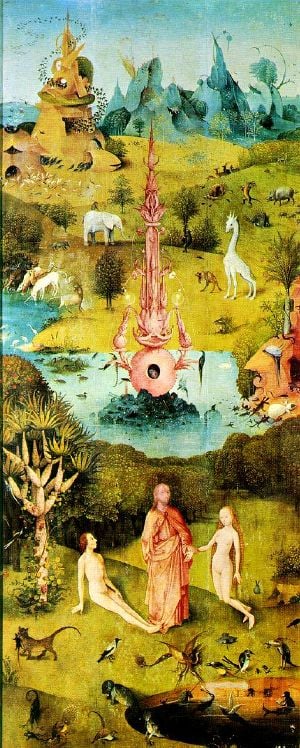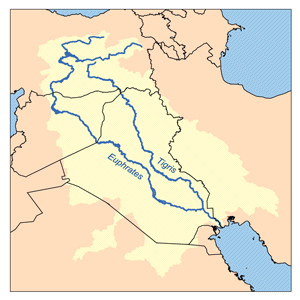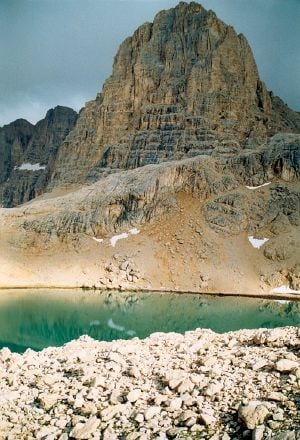Difference between revisions of "Garden of Eden" - New World Encyclopedia
m (→Eden in Art) |
m (→Critical views) |
||
| Line 91: | Line 91: | ||
::behind them, a desert waste—nothing escapes them. | ::behind them, a desert waste—nothing escapes them. | ||
| + | ==Critical views== | ||
| + | Biblical critics point out that the story of the Garden of Eden is clearly mythological and also that it contradicts the earlier version of Creation given in Genesis 1. | ||
| + | In the story of Eden, Adam is the first creation, formed from dust even ''before'' the plants and animals. Eve, on the other hand, is created last of all. The name of the Creator God is [[Yahweh]]. However, in Genesis 1, the unnamed first man and woman are created simultaneously on the sixth day of creation, only ''after'' God (called Elohim) creates the plants and animals. Genesis one describe a true paradise, in which there are only blessing and no commandments; nor is there any serpent to tempt the first couple. Genesis 2-3 presents the world as a dangerous place, in which a tempting poisonous fruit is prominent and Yahweh has created a serpent to lure Adam and Eve into sin. According to the [[Documentary Hypothesis]], the Garden of Eden story originated with the "J," or Yahwist, source, while Genesis 1 comes from the later P or priestly source, emphasizing the holiness of the [[Sabbath]] as the seventh day, in which even God rested from His labor. | ||
| + | |||
| + | Mythologists such as Joseph Campbell note that in early creation stories, there is also a garden and a tree of life, but no forbidden tree of knowledge. In this theory, the Yahwist's Garden of Eden story was designed to denigrate Canaanite traditions in which the "mother of all living" was not a woman, but a goddess, who shared her life-giving fruit freely; and the serpent was not an agent of sin but of healing and spiritual power. | ||
== The Restoration of Eden== | == The Restoration of Eden== | ||
Revision as of 04:05, 13 September 2007

The Garden of Eden (from Hebrew Gan Eden) is described by the Book of Genesis as being the place where the first man and woman—Adam and Eve—lived after they were created by God until their expulsion for disobedience. The past physical existence of this garden forms part of the creation belief of the Abrahamic religions.
The origin of the term "Eden", which in Hebrew means "delight," may be related to the Akkadian edinu, which derives from the Sumerian E.DIN. The latter words mean "plain" or "steppe."
The Genesis account supplies the geographical location of Eden in relation to four major rivers. However, because the identification of these rivers has been the subject of much controversy and speculation, many people believe that the knowledge of the location of Eden has been lost.
Some religions and cultures have a creation story containing a similar concept to the biblical Garden of Eden, ascribing various locations to the place of first habitation.
Biblical account
The story of the Garden of Eden story is found in Genesis 2-3. God, called Yahweh, creates Adam from the "dust of the ground" when "no shrub of the field had yet appeared on the earth and no plant of the field had yet sprung up." Yahweh then plants the Garden of Eden and placed Adam there. Yahweh then causes trees to grow in the Garden, including the special Tree of Knowledge of Good and Evil. From this tree alone Adam is commanded to refrain from eating, on pain of death. Seeing that Adam was alone, Yahweh decides to make a helper for him. Yahweh then creates the animals and brings them to Adam, who gives them names. However, none of them is an adequate mate for him. Yahweh then creates a woman from Adam's own body. Adam names her "woman." Both of them are naked and without shame.
Despite its paradise-like character, the Garden of Eden is not an entirely safe place. A talking serpent appears on the scene and begins to tempt the woman to eat of the forbidden fruit of the Tree of Knowledge of Good and Evil.
and that they were expelled from the garden after they disobeyed Him, having been tempted by a serpent and having eaten of the fruit. The Tree of Life, also planted in the garden, was then denied them by means of a physical barrier, of cherubim and a flaming sword, at the entrance to the garden. She resists, for she too understands that she and Adam have been commanded not to eat of this fruit. However, the serpent convinces her that they will not die by eating it, and shows her that the fruit is "good for food and pleasing to the eye, and also desirable for gaining wisdom." She eats of it, and gives some to Adam. As a result, "the eyes of both of them were opened" and they realized that they were naked. They feel ashamed of themselves and cover they sexual areas with fig leaves. They also begin to fear Yahweh because of their nakedness.
Yahweh walks through the Garden and looks for the couple in the Garden but cannot find them. When he discovers them hiding they reveal their shame over being naked, and Yahweh realizes they have eaten of the forbidden fruit. Although they do not die, as Yahweh had predicted they would, the consequences of their actions are dire indeed. Yahweh curses the serpent to crawl on its belly and eat dust. He curses the woman—who is still unnamed—to painful childbirths and to be subservient to her husband. He curses the land on account of Adam's sin. And He curses Adam to live by arduous labor, "for dust you are and to dust you will return." (Gen. 3:19)
Only then does Adam finally give the woman a name, Eve, meaning "the mother of all living."
After this Yahweh makes garments for Adam and Eve, but condemns them to live outside of the Garden of Eden. To prevent the couple from eating of the Tree of Life and living forever, he drives them out of the Garden and places two cherubim and a flaming sword at its entrance, "flashing back and forth to guard the way to the tree of life."
Location
The Book of Genesis contains little information on the garden itself. It was home to both the Tree of Life and the Tree of Knowledge of Good and Evil, and vegetation that could feed Adam and Eve. It also contained abundant animal life which apparently did not pose a threat to Adam or Eve, as well as a serpent who posed a very real threat to them.
However, in terms of the Garden's location, some fairly specific information is given.
| “ | A river flowed out of Eden to water the garden, and there it divided and became four rivers. | ” |
The text asserts that from Eden the river divided into four branches: Tigris, Euphrates, Pishon and Gihon. The identity of the latter two rivers have been the subject of endless argument, but if the Garden of Eden had really been near the sources of the Tigris and the Euphrates, then the original narrators would have identified it as located generally in the Taurus Mountains, in Anatolia.
Satellite photos reveal two dry riverbeds flowing toward the Persian Gulf near where the Tigris and Euphrates also terminate. While this accounts for four rivers in the vicinity, that area is the mouth of those rivers rather than their source.
Alternate locations
A number of other claims as to the geographic location of the Garden of Eden, though many of these has much connection to the text of Genesis. Many put the Garden somewhere in the Middle East near Mesopotamia, based on the references to the Euphrates and Tigris rivers.
Some of the historians working from within the cultural horizons of southernmost Sumer, where the earliest surviving non-Biblical source of the Eden legend lies, point to the Bronze Age commercial center of the island Dilmun (now Bahrain) in the Persian Gulf, described as "the place where the sun rises" and "the Land of the Living." This probable setting of the Sumerian creation myth, Enuma Elish, has clear parallels with the Genesis narratives. After its decline, beginning about 1500 B.C.E., Dilmun developed such a reputation as a long-lost garden of exotic perfections that some theorist believe it influenced the story of the Garden of Eden.
Various African locations have been suggested on the basis that human life is believed to have originated there according to most scientific theories. Locations as diverse as Ethiopia, Java, Sri Lanka, the Seychelles, and Bristol, Florida, have all been proposed as locations for the Garden. One recent claim by archaeologist David Rohl puts the garden in northwestern Iran. According to him, the Garden was a river valley east of Sahand Mountain, near Tabriz. He cites several geological similarities with Biblical descriptions, and multiple linguistic parallels as proof.
There is also an attempt to tie the location of Eden with the mystical sunken land of Atlantis. One suggested location of this Eden is Sundaland in the South China Sea. In this theory, the current Tigris and Euphrates rivers are not be the ones referred to in the narrative, but are later rivers named after two of the earlier rivers, just as in more modern times colonists would name features of their new land after similar features in their homeland.
In Latter-day Saint theology, the Garden of Eden is believed to be located at what is now inside the city limits of Independence, Missouri, and this land is considered among the most holy. Mormons believe the configuration of the continents was different before the Great Flood and that the geographical descriptions of Eden in Genesis refer to entirely different lands and rivers that were later renamed after more familiar local lands and rivers in the Near East after the Flood.
The Urantia Book (1955), a channeled revelation supposed to come from angelic beings, places the Garden of Eden in a long narrow peninsula projecting westward from the eastern shores of the Mediterranean and having been long ago submerged in connection with volcanic activity.
Many contemporary theologians believe that the Garden never had a terrestrial existence, but was instead an adjunct to heaven as it became identified with Paradise. Others take the story allegorically, seeing Eden as a psychological state rather than any physical location.
Biblical literalists answer that even though Eden may not exist today, it did once exist just as the Bible says it did. However, the world of Eden's time was destroyed during Noah's Flood.
Eden as Paradise
The word "paradise," often used as a synonym for the Garden of Eden, is originally a Persian word, which describes a walled orchard garden or an enclosed hunting park. It occurs three times in the Old Testament, though not in connection with Eden:
- in the Song of Solomon 4:13—"Thy plants are an orchard of pomegranates, with pleasant fruits; camphire, with spikenard" *Ecclesiastes 2:5—"I made me gardens and orchards, and I planted trees in them of all kind of fruits"
- Nehemiah 2:8: "And a letter unto Asaph the keeper of the king's orchard, that he may give me timber to make beams for the gates of the palace which appertained to the house, and for the wall of the city, and for the house that I shall enter into. And the king granted me, according to the good hand of my God upon me. ".
In the Song of Solomon, the term is clearly "garden;" in the second and third examples "park." In the post-Exilic apocalyptic literature and in the Talmud, "paradise" gains its associations with the Garden of Eden and its heavenly prototype. Literary Hellenistic influences led to the Pauline Christian association of "paradise" with the realm of the blessed. The Greek Garden of the Hesperides also influenced the Christian concept of the Garden of Eden.
Some anthropologists have hypothesized that the Garden of Eden does not represent a "geographical" place, but rather represents "cultural memory" of "simpler times," when man lived off God's bounty (as "primitive" hunters and gatherers still do) as opposed to toiling at agriculture (being "civilized")... a metaphor reinforced by the words of the Book of Genesis.
Other Biblical references
The Garden of Eden is rarely referred to outside the first chapters of Genesis. It is most prominently mentioned in the Book of Ezekiel, who speaks of the "trees of Eden" as a metaphor of fallen greatness, predicting that just as the Great Assyrian Empire fell to Babylon, so the Egyptian Empire—where Jeremiah then lived in exile—would one day also fall:
- Consider Assyria, once a cedar in Lebanon,
- with beautiful branches overshadowing the forest;
- it towered on high, its top above the thick foliage...
- The cedars in the garden of God could not rival it...
- no tree in the garden of God could match its beauty.
- I made it beautiful with abundant branches,
- the envy of all the trees of Eden in the garden of God...
- Those who lived in its shade, its allies among the nations
- have also gone down to the grave with it joining those killed by the sword.
- Which of the trees of Eden can be compared with you in splendor and majesty?
- Yet you, too, will be brought down with the trees of Eden to the earth below.
- you will lie among the uncircumcised, with those killed by the sword.
- This is Pharaoh and all his hordes, declares the Sovereign Lord.
The prophet Joel also refers to Eden as a metaphor of the current state of affairs compared to the coming doom:
- Like dawn spreading across the mountains a large and mighty army comes,
- such as never was of old nor ever will be in ages to come.
- Before them fire devours, behind them a flame blazes.
- Before them the land is like the garden of Eden,
- behind them, a desert waste—nothing escapes them.
Critical views
Biblical critics point out that the story of the Garden of Eden is clearly mythological and also that it contradicts the earlier version of Creation given in Genesis 1.
In the story of Eden, Adam is the first creation, formed from dust even before the plants and animals. Eve, on the other hand, is created last of all. The name of the Creator God is Yahweh. However, in Genesis 1, the unnamed first man and woman are created simultaneously on the sixth day of creation, only after God (called Elohim) creates the plants and animals. Genesis one describe a true paradise, in which there are only blessing and no commandments; nor is there any serpent to tempt the first couple. Genesis 2-3 presents the world as a dangerous place, in which a tempting poisonous fruit is prominent and Yahweh has created a serpent to lure Adam and Eve into sin. According to the Documentary Hypothesis, the Garden of Eden story originated with the "J," or Yahwist, source, while Genesis 1 comes from the later P or priestly source, emphasizing the holiness of the Sabbath as the seventh day, in which even God rested from His labor.
Mythologists such as Joseph Campbell note that in early creation stories, there is also a garden and a tree of life, but no forbidden tree of knowledge. In this theory, the Yahwist's Garden of Eden story was designed to denigrate Canaanite traditions in which the "mother of all living" was not a woman, but a goddess, who shared her life-giving fruit freely; and the serpent was not an agent of sin but of healing and spiritual power.
The Restoration of Eden
External links
- Returning to Eden investigates the Garden of Eden motif from a political, historical, and philosophical perspective, viewing it as a precursor of political utopianism.
- Smithsonian article on the geography of the Tigris-Euphrates region
- Review of the Young Earth Creationist Book "After Eden"
Credits
New World Encyclopedia writers and editors rewrote and completed the Wikipedia article in accordance with New World Encyclopedia standards. This article abides by terms of the Creative Commons CC-by-sa 3.0 License (CC-by-sa), which may be used and disseminated with proper attribution. Credit is due under the terms of this license that can reference both the New World Encyclopedia contributors and the selfless volunteer contributors of the Wikimedia Foundation. To cite this article click here for a list of acceptable citing formats.The history of earlier contributions by wikipedians is accessible to researchers here:
The history of this article since it was imported to New World Encyclopedia:
Note: Some restrictions may apply to use of individual images which are separately licensed.



